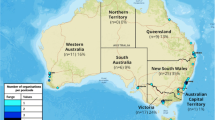Abstract
Background. The use of complementary and alternative medicine (CAM) among cancer patients has increased substantially during the last decade. The purpose of this investigation is to summarize CAM content of comprehensive cancer control (CCC) plans in the United States, territories, and tribes. Methods. Sixty-six CCC plans, including all the states, most of the territories, and nearly all the Native American tribes were analyzed for content of CAM, and predominant thematic areas were summarized. Results. Thirty-nine plans (59.1%) included CAM content. The predominant themes identified included increased education of CAM practices (46.2%), followed by utilization of existing CAM providers (28.2%), increasing CAM research efforts (18%), encouraging patient and provider communication about CAM use (18%), establishment of CAM baseline data (10.3%), and CAM as a barrier to treatment (10.3%). Conclusion. CAM is an emerging area in cancer care. The increasing inclusion of various themes of CAM into CCC plans indicate that many US cancer coalitions are taking steps to include the education and promotion of safe and efficacious CAM therapies for cancer patients.
Similar content being viewed by others
References
Eisenberg DM, Davis RB, Ettner SL, et al. Trends in alternative medicine use in the United States, 1990–1997: Results of a follow-up national survey. JAMA. 1998;280:1569–1575.
Cassileth BR, Lusk EF, Strouse TB, et al. Contemporary unorthodox treatment in cancer medicine: a study of patients, treatments, and practitioners. Ann Intern Med. 1984;101:105–112.
Richardson MA, Sanders T, Palmer JL, et al. Complementary/alternative use in a comprehensive cancer center and the implications for oncology. J. Clin. Oncol. 2000;18:2505–2514.
National Cancer Institute. Directory of Cancer Terms. Bethesda, MD: Office of Cancer Complementary and Alternative Medicine. Available at http://www.cancer.gov/Templates/db_alpha.aspx?CdrID=44384. Accessed November 2008.
Centers for Disease Control and Prevention. National Comprehensive Cancer Control Program. Atlanta, GA: U.S. Department of Health and Human Services, Centers for Disease Control and Prevention. Available at http://www.cdc.gov/cancer/ncccp/. Accessed June 2008.
Centers for Disease Control and Prevention. Comprehensive Cancer Control Plans: A Content Review. Atlanta, GA: Centers for Disease Control and Prevention, Division of Cancer Prevention and Control and ORC Macro; 2004.
Federated States of Micronesia: National Comprehensive Cancer Control Plan. Cancer Control P.L.A.N.E.T. Web site. Available at http://ccplanet.cancer.gov/state_plans/Federated_States_of_Micronesia_ Cancer_Control_Plan.pdf. Accessed May 2008.
Barnes P, Powell-Griner E, McFann K, Nahin R. CDC Advanced Data Report #343. Complementary and alternative medicine among adults: United States, 2002. May 2004. Accessed June 2008.
U.S. Cancer Statistics Working Group. United States Cancer Statistics: 2004 Incidence and Mortality. Atlanta, GA: Department of Health and Human Services, Centers for Disease Control and Prevention, and National Cancer Institute; 2007. Available at http://apps.nccd. cdc.gov/uscs/. Accessed June 2008.
National Cancer Institute. 2006 Fact Book. Bethesda, MD: National Cancer Institute; 2007. Available at http://obf.cancer.gov/financial/ attachments/06factbk.pdf. Accessed June 2008.
Steyer TE, Freed GL, Lantz PM. Medicaid reimbursement for alternative therapies. Altern Ther Health Med. 2002;8:84–88.
Pelletier KR, Astin JA. Integration and reimbursement of complementary and alternative medicine by managed care proveders: 2000 update and cohort analysis. Altern Ther Health Med. 2002; 8:38–48.
Complementary and Alternative Medicine in Cancer Treatment (PDQ*). National Cancer Institute website. U.S. National Institutes of Health. Available at http://www.cancer.gov/cancertopics/pdq/cam/ cam-cancer-treatment/patient/allpages. Accessed June 2008.
Irwin DE, Zuiker ES, Rakra-Burris T. Millikan RC. Review of state comprehensive cancer control plans for genomic content. Prev Chronic Dis [serial online]. April 2005. Available at http:// www.cdc.gov/ped/issues/2005/apr/04_0128.htm. Accessed June 2008.
Author information
Authors and Affiliations
Corresponding author
Additional information
Supported by National Cancer Institute grant no. 5R25CA76023, Cancer Research Experience for Students (CaRES) at the University of Alabama at Birmingham.
Rights and permissions
About this article
Cite this article
Lo, C.B., Desmond, R.A. & Meleth, S. Inclusion of complementary and alternative medicine in US state comprehensive cancer control plans: Baseline data. J Canc Educ 24, 249–253 (2009). https://doi.org/10.1080/08858190902972897
Issue Date:
DOI: https://doi.org/10.1080/08858190902972897



